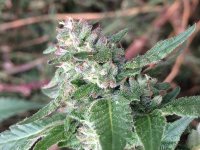TychoMonolyth
Boreal Curing
Water crystals can help a lot.last year we had 19 days of +20c rest was under that.. this year 60 days +20c over but season is now ended only +10c days with sun, nights hitting almost 0 and there is some frost on the grounds.. this year we had record drought farmers losing cheap crops that you cant water without losing money like common wheat.. it grew mini size this year and some drier spots of fields did not grew anything.. i watered what i could 1 time in spring and left them to suffer.. we hardly ever have this kind of droughts but if it gets more common i need to start thinking watering systems
i cant tell much about the last years genetics becouse my boxes was cardboard and they broke up and shit fly all over the fuckin trailer .. they are semi-auto-autos but in lower latitudes i guess they all autoflower.. if you have under 16 hours of daylight in summer..
sweden sucks..
lol. not funny but.... funny.
Go buy some fancy cookies, throw away the cookies, and use the tins for your seeds.

Still, I'd love those seeds.
Or go to the Dollar Store (Euro Store?) and get some tins.










